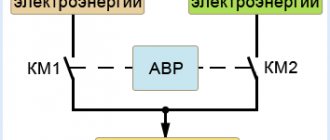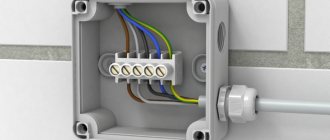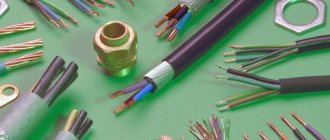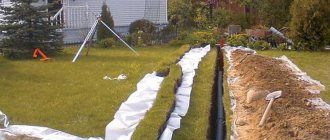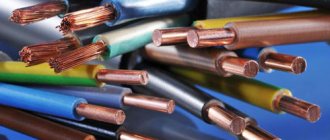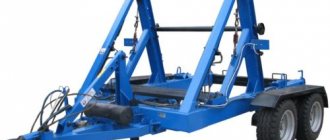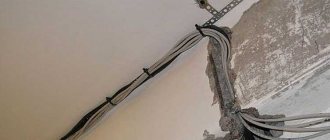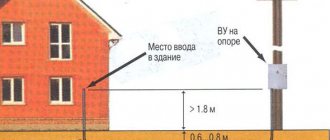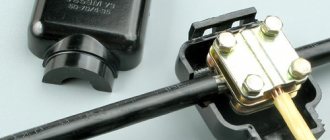When building or reconstructing a house, as well as modernizing electrical networks, it becomes necessary to connect a new electrical cable to the house. For such a connection, which is made from a power line support, a self-supporting insulated cable (SIP) is most often used. Let's consider the stages of installation and connection of the cable from the support to the house, methods of connecting wires to the support and common mistakes when performing this type of electrical work.
SIP installation rules
With the growing number of energy consumers, SIP wires are effectively replacing conventional bare wires due to their practicality, reliability and safety. Self-supporting wire is widely used in the construction of new power lines, and SIP of four different modifications is also very popular in everyday life. Laying an electrical network using a self-supporting wire allows you to reduce the time it takes to put electrical networks into operation and provide electricity to residential and industrial facilities as quickly as possible. But to carry out installation work yourself, you need to know how to fasten SIPs. Methods for attaching SIP to a pole, types of fasteners, types of self-supporting cables, installation rules, recommendations from specialists when working with SIP will be discussed below.
Material for attaching SIP to the facade of the house
Fortunately, material manufacturers produce a wide variety of linear fittings for SIPs, but unfortunately, all manufacturers label them differently.
Let's look at the picture of fastening 2×16 SIPs to the facade of the house. This is the cross-section that is used for the subscriber branch.
Fastening the subscriber branch SIP 2×16 on the facade of the building
We see the following material:
| 1. Anchor bracket KAM-4000 (IEK), CA 1500/2000, SO 253. |
| 2. Anchor clamp ZAB 16-25 (IEK), PA25x100 |
| 3.Facade fastening KFK12-47.1, SO90.1, SF 10, BRPF 70-150-1F |
Fastening principle
- The bracket is attached to the facade;
- The SIP is tensioned from the support with an anchor clamp;
- In order for the SIP to be neatly laid along the facade of the house, before entering it into the house, it is secured to the facade with facade fasteners.
Description and types of SIP
A self-supporting electrical wire consists of several wires isolated from each other (aluminum wire intertwined). When laying new lines in accordance with GOST R 52373-2005, it is necessary to use a self-supporting cable. According to the new PUE rules, these cables are recommended to be used to connect electricity consumers.
Today there are the following types of SIP:
- SIP-1. This is a four-core cable used in three-phase electrical networks with voltages up to 1000 V. Moreover, three of its cores are designed for connecting phases (isolated from each other), and the fourth (zero) is without braid and has a steel core. They also produce SIP-1A cable, in which the neutral core is insulated.
- SIP-2. All cores in this cable are insulated. Its scope of application is the same as that of the cable described above.
- SIP-3. This is a single-core wire with polyethylene insulation. Thanks to the steel core, it is highly durable. It is used in electrical networks up to 35 kV.
- SIP-4. This is a four-core cable with polyethylene insulation, designed for power lines up to 1000 V. It does not have a steel core. It is often used to make branches from the main power line in country houses and in the private sector.
- SIP-5. It includes two or more insulated conductors, all of them without a steel core. This cable is used in electrical networks up to 1000 V.
Advantages and disadvantages of using SIP
These wires allow:
- ensure the required electrical safety class;
- increase network reliability during operation;
- reduce the cost of maintaining the electrical network (up to 80%);
- reduce installation time and reduce labor costs;
- place electrical lines on the walls of buildings;
- reduce losses during electricity transmission (due to low resistance);
- connect objects without disconnecting the main supply line;
- lay and connect lines on your own.
- cost 20-25% more than conventional wires without insulation;
- many energy suppliers are not ready to use SIP (outdated equipment and no tools for installation);
- Only overhead power lines can be laid.
Types of fasteners for SIP
To lay a self-supporting wire, use the following fasteners:
- intermediate support clamps;
- brackets for fastening anchor clamps;
- brackets for fastening intermediate clamps;
- anchor brackets for power consumer wires;
- anchor clamps for insulated load-bearing neutral core;
- anchor clamps for power consumer wires;
- mounting hooks;
- fastening tape (the tape must be made of stainless steel);
- stainless steel clamps;
- stainless steel yokes;
- fastening ties;
- facade fastenings for SIP;
- Spiral knits.
Many clamps allow you to attach two self-supporting cables at once. To do this you need to use another clamp. In this case, fastening the SIP will save not only materials, but also free space. Do not use simple cable ties for this purpose. You only need to install clamps for the self-supporting wire - they are wide. In addition, they are made of high-strength plastic, so they are more durable.
Anchor clamps
Using these clamps, SIPs with an insulated load-bearing neutral core are secured. The anchor clamp consists of a body and self-adjusting wedges that allow you to carefully clamp the neutral core.
Thanks to the flexible cable, you can install up to three clamps on one bracket.
Facade and pillar brackets
The brackets securely hold the anchor clamps on the facade. They differ in design. When choosing these fasteners, you need to consider the purpose for which the cable is used, because power wires often get very hot (heating of the cores up to 90°C is allowed). Such fittings for fastening SIPs must provide a large gap between the walls and the cable so that it is well cooled.
For installation with tape, use brackets with large limiting projections. During the operation of power lines, a backlash appears in them, which is associated with the stretching of the tape. If these SIP fastening units are on supports with small protrusions, then it can jump off the fastening point.
What materials are anchor clamps made from?
All parts of SIP fittings are outdoors around the clock. These elements must be resistant to the negative effects of external factors. For this reason, high demands are placed on the production and quality of fastening elements. During the production of anchor clamps, materials are used that are resistant to humid environments, low and high temperatures, ultraviolet rays, and do not corrode:
- stainless steel alloy;
- Aluminium alloy;
- Cink Steel;
- high strength polymer.
The first step is to eliminate the risk of rust on parts. A decrease in the quality of contact leads to many problems in the future. Do not forget that ultraviolet rays can also affect the quality of fasteners. It is for this reason that PVC casing is used during production. The clamps have wedge inserts with teeth made from a high-strength metal alloy. Aluminum cases do not oxidize or become magnetic, and do not show rust stains. The loss of electrical energy as a result of contact reversal is minimal.
Tools and accessories for working with SIP
The following allow you to install a self-supporting wire efficiently and safely:
- tools for tensioning steel mounting tape;
- cable cutting scissors;
- scissors for cutting steel tape;
- winches;
- mounting stockings;
- mounting clamp;
- mounting rollers;
- swivels;
- hydraulic presses for crimping insulated sleeves and tips with cord brush;
- dynamometers;
- cord brushes;
- tools for installing reinforced ties;
- insulated spanners;
- grounding kits;
- separating wedges;
- short-circuit devices;
- universal claws and manholes;
- safety belts;
- slings;
- device for twisting wires.
SIP installation instructions
This self-supporting wire is installed in stages.
The first stage is preparatory work.
At this stage you need:
- cut down and uproot trees and bushes under power lines, as well as around the installation site of tension and control devices. If these requirements are not met, the SIP insulation may be damaged during rolling;
- prepare the necessary tools and equipment.
The second stage is the dismantling of old poles and installation of new ones.
At the second stage, the old pillars are removed and new ones are installed. At the same time, before installing new supports, fasteners must be secured to them, because after installation, installing reinforcement on the support for fastening SIPs is problematic and more labor-intensive.
Reinforced concrete, wooden and iron supports are often installed under SIP. In this case, in places where the line turns, it is necessary to use double SIP anchors at an angle of 90°.
During installation, it is recommended to use double SIP anchors at turning points to securely fix the cable and protect it from damage.
The third stage is rolling out, fastening, tensioning SIP and connecting the energy consumer.
Self-supporting wire is supplied from manufacturers in spools. It can be rolled out manually with conductor sections up to 5 cm² and line lengths up to 100 m. In populated areas, you can manually roll out SIPs if the supports are located at a distance of up to 50 m from each other. In this case, you must comply with the basic safety requirements given below.
Sections and grades of sip are indicated in this table.
During rolling, the following rules must be observed:
- Be sure to use rollers in the work, because they protect the insulation from damage. It is impossible to roll out SIP on the ground due to the likelihood of damage to the polyethylene insulation and contamination of the cable with the ground. When installing a piercing clamp on contaminated soil, additional resistance appears, which leads to loss of electricity and overheating.
- Installing swivels is also a mandatory requirement, because it protects the multi-core cable from the cores unwinding, which leads to the appearance of gaps between them. These places can cause the wire to break due to external loads (strong wind or falling branches).
- The use of a connecting stocking allows you to maintain the integrity of the insulation and reliably connect the rope to the cable.
- When unrolling manually, the unwinding speed should not exceed 5 km/h so that the cable does not touch the ground, buildings and supports.
The rolling process is as follows:
- Place the reel on a stand or unrolling trolley.
- Place the stand behind the first pole of the power line being created (at a distance not less than the height of the support).
- Attach the mounting roller to the pole.
- Auxiliary rollers are attached to the remaining supports. They have different designs and markings because they are used on straight sections and on turns.
- Next, an auxiliary rope is passed from the end of the power line being installed to the beginning. For these purposes, use a rope of 6 mm or more.
- Then a rope is attached to the beginning of the cable. In this case, a mounting stocking and a swivel are used for connection to properly unwind the wire from the spool.
- Next, pull the rope and stretch the wire (placed on rollers) along all the posts. At the same time, slowly rotate the reel and pull the rope evenly. For this purpose it is allowed to use winches.
- Then they stretch and fasten the SIP in the anchors.
- Then remove the rollers and put clamps in their place.
- Next, the necessary branches from the power lines are made.
- At the final stage, the cable is installed and connected to the electric meter.
Installation of SIP on walls and siding
SIP insulation can be flammable, so attaching it to siding in the usual way is prohibited. To do this, you can use a metal sleeve (in which the cable is placed) and facade fasteners. To make a metal sleeve look aesthetically pleasing, you need to use a sleeve with double insulation.
But this option has pros and cons.
Advantages of facade fastening for SIP:
- The line looks the most attractive.
- Allows you to create increased protection.
- Costs for purchasing an iron hose and its fastening.
- It is impossible to create the necessary tightness of the structure.
- When laying the cable in a pipe, its cooling deteriorates.
- In hot weather, with an acceptable load, a self-supporting cable is not capable of passing the maximum permissible current. Therefore, insulation is often broken.
It must be remembered that ordinary self-supporting wire must not be laid inside the connected object. For these purposes, a non-flammable self-supporting cable marked Ng is provided.
Material
Before installation, you must purchase all the material, namely:
- ⚡SIP 4*16 or SIP 2*16 (depending on the input 220V or 380V)
- ⚡Bandage tape SOT37 ~ 2.5-3m (for attaching the hook to the support)
- ⚡SOT36 clamp – 2 pcs (tape fixation)
- ⚡Bandage hook SOT39 or SOT29 – 1 piece
- ⚡Wall hook SOT28 or SOT76 – 1 piece and mounting
- anchor bolts to it
- ⚡Anchor clamp SO80 or SO158 – 2 pcs
- ⚡Puncture clamps SLIP12.1 – 8 pcs (for 380V input) and 4 pcs (for 220V input)
The brands of materials from the manufacturer ENSTO are indicated here; in your case, the specification (SLIP, SO, SOT, etc.) may not be the same, but the names themselves (piercing clamp, anchor clamp, clamp) should be the same.
Before starting work, it will be necessary to take certain measurements. The distance from the support to the facade of the house where the wall hook will be located should be no more than 25 m. Otherwise, you will have to install an additional support support.
Choose SIP depending on what input you will be installing into the house - 220V or 380V. When purchasing SIP, it is better to make some reserve in footage for all sorts of unforeseen situations. Basically, the 4*16 SIP brand is used for entering the house.
Tingle clamps will be required to connect to the main power line. Their choice is very large, there are even some that can be used without removing the voltage from the power lines. The shear head of the bolt is isolated from the contacts. First of all, pay attention to the cross-section of the wire and select the brand of clamp for it.
It is important to make one note.
If the main overhead line to your house is made of bare, uninsulated wires, then the clamps must be appropriate. One side for contacts has a smooth surface, the other has teeth. When there is also an SIP hanging on the main power line, in this case, choose clamps with piercing teeth on both sides of the contact substrate.
clamp for connecting to bare wires
Two hooks are installed on the support and facade of the house. It is between them that the SIP is stretched. Its fixation is carried out with anchor tension clamps.
Installation of SIP wire: fastening, connecting the house to the electrical network
Insulated wires have long replaced traditional ones. They are connected to the building and laid out on supports. This line is called VLI. Often a self-supporting insulated wire is called a cable, which in principle is also true.
The use of insulated wires is convenient because it reduces the risk of electric shock to a person if the line breaks, and also eliminates the possibility of electricity theft.
The SIP wire is installed in accordance with the instructions and technological maps.
Rules and procedure for the construction of VLI
The construction of overhead lines is carried out by a specially trained team of electricians. Installation begins with preparatory work, including clearing the route from vegetation and other obstacles.
Before rolling out the wires, all supports must be installed, passages through engineering structures must be protected, and, of course, drums with the wire itself must be delivered.
If VLI is supposed to supply electricity to the house, anchors must be installed on the building in advance for hanging SIP wires.
Installation of the drum and auxiliary mechanisms
Wire rolling begins by installing the drum. It is placed near the support where the final adjustment of the booms will be made. Moreover, the optimal distance between them is considered equal to the height of the support itself.
For manual rolling of wires, a special leader rope is used. This is a kind of synthetic cable with a length of 30 to 50 m and a diameter of 10 mm. The rolling out of the rope is carried out simultaneously with the fastening of the rollers and intermediate hangers on the supports. As the rope rises, the intermediate suspension is fixed to the pole with a special metal tape. If the support is equipped with a hole, the suspension can be secured using a bolted connection.
The intermediate suspension bracket is equipped with a hole. The rolling roller is attached here. The number of hangers and rollers depends on the number of complex pillars, intermediate, corner and anchor supports. It is important to maintain the correct position of the rollers so that the axis of the cable being laid is at the level of the recess of the support clamp.
The videos have some differences.
- The RT 5 mechanism is installed on complex and anchor poles. They are secured with a belt;
- The RT 2 mechanism is designed for intermediate supports. They are attached to the hole in the intermediate suspension bracket.
After completing the installation of all mechanisms, the leader cable is connected to the end of the SIP wire. To connect the cable and cable together, use metal stockings with a swivel. Moreover, stockings differ in purpose.
At the same time, a mechanism is used that is put on the cable itself and the neutral core, and the entire harness is crimped with a synthetic stocking. A double bandage made of electrical tape helps to increase the reliability of the connection. The main stocking is equipped with a weight ring.
The leader rope is attached to it.
Manually rolling out wire between supports
Manual rolling of SIP wires is carried out in sections limited to 100 m or between spans up to 50 m. The team performs the work in the following order:
- When everything is prepared for work, the team is divided into 3 units. The first and second links each include one electrician. Their duty is to monitor the operation of the unwinding mechanism motor, the uniform winding of the rope onto the reel and the smooth rotation of the wire drum. The third link monitors the passage of the connecting node of the rope with the cable along the unrolling rollers.
- The rolling continues until the connecting knot passes through all the posts and approaches the reel itself with a fully wound leader rope. At this time, a command to stop the engine is given. The cable is fixed to the anchor post with a nylon cable, after which the connecting unit is disconnected. A free piece of cable is left at the end supports for subsequent connections.
When rolling out the SIP wire, it is important to monitor its passage on the corner supports and prevent the sagging cable from rubbing against the ground.
Fixation and tension of SIP
SIP fastening is first carried out on the anchor supports of the span. Here the cable is fixed using anchor clamps. Next, the SIP is fixed to the intermediate posts. The tension of the neutral core is carried out according to the installation tables, but not more than 5% of the force of the design values. The sag of the arrows is determined visually, after which they are left to sag a little.
The next shift crew begins adjusting the booms:
- On the first anchor support, the clamp is installed on the zero core. A plastic clamp is placed near the clamp on the entire wire harness. It will not allow the tourniquet to unwind.
- The next clamp is placed on the final support bracket. A dynamometer is fixed to the load-bearing core away from the pole with a clamp. The cable of a hand winch, which is pre-attached to the first pillar of the span, is attached to it.
- While pulling the SIP wire towards you with a winch, look at the force on the dynamometer. When the desired value is reached, the zero core is fixed with a clamp on the bracket of the final support.
The wire tension is completed, all that remains is to tighten all the wires with a clamp and unhook the winch.
Independently connecting your home with SIP wires to the line
You can connect the SIP to the house yourself, but you will have to entrust its connection to the line to electricians. However, in order to correctly install the cable, you need to familiarize yourself with the technical standards, which can be obtained from the relevant organization. Making such demands is justified by the safety of the entire line, and not just your home.
Basic Installation Requirements
To install a SIP cable from the line to your home, you need to know the basic requirements:
- the minimum height of the supply cable above the ground is 2.75 m;
- a similar distance must be maintained from windows, doors and loggias.
Typically, the consumer connection is made using a SIP 4 cable without a supporting core. The cross-section of such a wire is 16 mm2, which meets the requirements of the PUE. Conductors of a smaller cross-section may not withstand the load, so such cables are prohibited from being used for entry into the house.
Before you start pulling the cable into the house with your own hands, you need to draw an exact diagram of its passage from the pole to the building. This will help you take measurements to purchase the wire.
Moreover, you need to buy SIP with a small margin, taking into account measurement errors. It is important to pay attention to the number of cable cores. If the connection is single-phase, it is enough to connect 2 wires to the house, that is, a phase and a zero.
For a three-phase connection you will need 4 wires.
The house input will have to be connected to the main line. To do this, you will need to install a special connector on each core. It is best to connect SIPs with piercing clamps. They will eliminate the need for stripping cable ends and ensure a tight connection.
When laying an overhead connection line from the pole to the house with your own hands, you must take into account the PUE standards. The rules clearly state that the maximum distance from the consumer input to the support is 25 m, otherwise an intermediate pole will have to be installed.
Which wire is better to introduce into the house?
A dispute often arises that SIP is not suitable for entry into a building. Why? After all, it is isolated and also resistant to many negative factors. In fact, this is true, and it can be introduced inside the house.
However, SIP is very rigid and does not bend well, which increases the complexity of installation. It is recommended to lay a cable with copper conductors inside the building, since this metal is the best conductor of electricity.
Many electricians recommend making internal input using a VVGng cable.
To make an entrance to the house, a distribution panel is installed on the facade. A self-supporting insulated wire is connected to it, inside it is connected to automatic circuit breakers and an electric meter, and from them a copper cable is brought out into the house.
Rules for laying cables along the facade of a building
The task itself looks somewhat strange. Why run wiring along the facade? First, let's understand the terms. If you go into the details of GOST: “a wire is a wire with or without a sheath...”, and “a cable is several wires...” and so on, you can get completely confused. Moreover, installing the wire along the wall of the building is impractical in principle. It must be inside. And if this is a power input, laying the cable along the facade of the building is generally prohibited; immediately after the suspension point it must be brought into the room.
All this is true, but we will talk about a relatively new cable (or wire, as defined by GOST) - SIP.
Self-supporting Insulated Wire (after all, a wire!) has recently been actively replacing non-insulated power wires. Residents of private houses know very well what it is. So, SIPs are allowed to be laid on the facades of buildings, and the norm is prescribed in the Rules for the Construction of Electrical Installations. When organizing the connection of households, this can bring significant savings for the owner.
General principle of power supply for a private home
From a transformer substation or public step-down transformer, the power supply is distributed through overhead line (OHL) wires throughout the village where your private home is located. A branch (input) is made from the overhead line to a private house.
The route to the house can be done by air, the so-called “airlift”, or by a trench in the ground. The choice of the type of power supply branch to the house depends on the geodesy of the area, the distance of the house from the overhead power distribution lines, the presence of forest plantations around the house, the passage of underground utility routes near the house, etc. But no matter what type of power supply branch to the house you choose, you have to connect the branch cable (connections) to the overhead line (OHL) wires. Let's look at this in more detail.
Important! The connection of the power supply branch to a private house from the overhead line must be done by specialists from the energy supply organization. However, it doesn’t hurt to understand what is being offered to you as a thrifty owner.
In what cases is it necessary to lay a power cable along the facade?
The most obvious option: if an obstacle in the form of a building appears in the path of an overhead power line. It can be bypassed by organizing a route loop in the power line. But it will cost extra design money, and extra wire, not to mention poles. This is how they used to do it (when power lines were built only on bare wires). And since the Rules for the Construction of Electrical Installations (PUE) allow the laying of SIP along the facade (or any other walls), it is possible to draw a power line directly through the obstacle.
But this applies to energy drinks. We are interested in the applicability of the PUE permit for private houses, in the area of responsibility of the owner of the property.
- If the switchboard in the house is located on one side, and the main power line is on the other, it was necessary to install another pole (the length of the overhead line is limited in length). Often right on the site. A self-supporting insulated wire is laid through the air to the nearest point of the building, and to the switchboard it can go along the wall.
- The mounting point from the pole is too high on the wall, and the shield is located at the surface of the ground. It is necessary to organize the so-called cable lowering. The SIP is attached to the wall before entering the panel.
As an alternative, a transition is made from the aluminum conductors of the self-supporting wire to the copper conductors of the input power.
And then the usual cable is laid along the facade.
Information: why make transitions from aluminum SIP to conventional VVG?
It would seem easier to tighten the input wire directly into the shield without buying crimp sleeves or piercing couplings. But connecting the SIP to the metering device (meter) is so problematic that it is easier to make the transition and lay the VVG cable along the wall of the building.
Inputting electricity into the house
As already noted, the connection of the input cable must be carried out by representatives of a specialized organization involved in power supply.
Currently, a residential building can be connected to power lines in three main ways:
- Laying an overhead line from a pole using bare aluminum wires. This method is considered the most dangerous and in practice its use has been significantly reduced.
- Input device from the overhead line with a self-supporting insulated wire (SIP cable). Reliable insulation allows you to avoid short circuits in any situation, and in the event of a cable break, there is no danger of electric shock to people.
- Entry into the house with a special armored cable laid underground. This method is considered the safest, especially for wooden houses, but also more expensive.
Since the main topic is SIP cable, it is worthwhile to dwell on its use as an input in more detail. This method is widely popular due to its design features and technical characteristics. However, when using this cable, certain conditions must be observed, especially when laying it along the wall of a wooden house.
Many experts are against the placement of SIP even in stone and brick houses. They consider the wire insulation to be insufficiently reliable in terms of physical strength characteristics. In this regard, SIP cables should not come into contact with any types of building structures. This reinsurance is explained by the protection of the overhead line from short circuit by an automatic circuit breaker, which is designed for a very high operating current. That is, the shutdown of the protective switch installed at the substation occurs with a certain delay. During this time, a powerful electric arc with a high temperature is quite capable of setting fire to the dry structures of a wooden house. However, there are many supporters of this method of laying, subject to certain safety measures.
One of these methods is to use a thick-walled metal pipe for insertion, which effectively localizes the action of the electric arc
Particular attention should be paid to the entrance and exit of the SIP cable from the pipe. To avoid possible chafing of the wire on the end of the pipe, it is provided with additional protection using a corrugated tube
One of the options for the input device could be a transition device from aluminum SIP conductors to a cable planned for laying inside a wooden building. It must be fire resistant and not spread fire. This part of the input, extended to the shield, is additionally protected by a circuit breaker. The machine is also used when bare wires are used connected to a piece of connecting cable. In all cases, the nominal value of the machine must be higher by one value compared to the input panel.
What does the Electrical Installation Rules say about this?
- The cable being laid should not experience tension or pressure loads.
- At transition points (couplings, piercing connections, etc.) insulation must be provided, the properties of which correspond to the characteristics of the main wire.
- All outlets and connections must be accessible for inspection and repair without mechanical intervention in the building structure.
- All connections of wire and cable cores are made in accordance with the PUE: crimping, welding, soldering or crimping.
- In the case when the cable is laid along the facade using pipes, flexible hoses, closed boxes, the possibility of quickly replacing the wiring is provided.
- Structural elements, insulation, transition points must be selected based on the environment of use: weather conditions, exposure to ultraviolet rays, temperature conditions.
- Metal parts of the structure must be protected against corrosion.
- The length of the cable laid along the wall of the building is calculated taking into account the temperature gaps for compression and tension. The movement of the wire under the influence of temperature should not create conditions for mechanical tensile forces.
- In places of connection, branching, transitions, slack is provided (cable reserve in case of reconnection or repair).
Laying cables along the facade of a building without making a transition
General rules for external installation on the wall of a building:
Minimum distances to elements for horizontal installation:
- above the frames of windows or doors - 30 cm;
- under window frames or balcony platforms (lower plane) - 50 cm;
- above the ground - 275 cm.
Minimum distances to elements for vertical installation:
- to window frames - 50 cm;
- to the edge of balconies or doors - 100 cm.
The minimum distance from the SIP to the wall is 6 cm.
The last point requires decoding. It refers exclusively to SIP, and is associated with the features of its design. This wire does not have an outer layer of insulation; only the current-carrying conductors are coated. The insulating material (PET) supports combustion and retains its properties only at temperatures up to 70–90°, depending on the modification. In addition, there is a SIP with a bare core, which is used as a zero wire.
Due to its low fire resistance, this cable should not be attached close to the wall. If the cable catches fire, the fire will not spread to the wall. For installation, special façade fastenings are used.
Important! If, after laying the cable, insulating panels will be mounted on the wall, the distance to the self-supporting insulation insulation is calculated according to the new outer plane, increasing by the thickness of the panels.
We start dancing from the façade wall
First of all, you need to select a point on the wall from which the branch will begin. The rules for electrical installations do not regulate the choice of wall: it can be front or side. But in practice, in our latitudes it is the façade that is chosen. Roof slopes usually extend onto the side walls of buildings, from which ice (icicles) or snow can fall off.
The starting point for laying on the wall is considered to be the point where the cable exits the anchor clamp. The main design elements are shown in the illustration:
- Anchor bracket.
- An anchor clamp, after which the wire is not held on the overhead line route.
- Facade fastening is the first element of the wall installation system.
The bracket is installed at a height of at least 2.75 meters. The distance to the nearest corner of the load-bearing wall (excluding the thickness of the insulating material) is at least 10 cm.
Tip: If the cross-section of the power cable allows you to choose between different anchors, you should choose a hanger with a lower load. In this case, if there is a mechanical impact on the SIP (for example, caught by a truck on the road, or a pole falls), the wall will not be destroyed, the anchor will simply be torn off.
Laying on the wall
Next, facade fasteners are used. If you purchase factory fittings, the distance is already regulated: at least 6 cm from the cable to the wall.
Then the cable route is marked and holes for fasteners are prepared. The distance between the fastening points is usually at least 70 cm. In bending areas, the frequency of fastening increases to prevent free sagging.
Important! If SIP is used, it is necessary to take into account the requirements for the geometry of the gasket. The bending radius is at least 10 cable diameters.
Then, using standard bolts, all facade fastenings are secured. To prevent corrosion and destruction of fasteners, the metal caps are closed with special plugs.
If house communications are located along the laying route, it is necessary to ensure a safe distance. At least 10 cm to water pipes, at least 40 cm to gas pipes.
Important! It is prohibited to form loose cable loops near metal structures.
Under wind load, the cable can fray the insulation and the wires will short out.
The use of fasteners that are intended for other purposes is not permitted. For example, pipe clamps or cable clips for indoor installation.
Common mistakes
During the construction of a power line, it is necessary to strictly comply with the requirements of current regulations and standards that can affect the reliability of power supply. That is why it is necessary to be especially careful when choosing linear coupling fittings and calculating the parameters of the overhead line.
Mistakes can have very serious consequences. You can prevent or minimize their occurrence by remembering the following important nuances:
- Before making a final decision during the acceptance of an overhead line, it is necessary to rely not only on the results of a visual inspection of the already erected line, but also on the correctness of the installation, during which personal presence is required.
- To lay the main line, materials must be used that meet the requirements for the overhead line under construction.
- The installation team must have all the necessary equipment, tools and accessories available.
- Only trained personnel should be involved in the construction and maintenance of the highway.
- It is allowed to start laying a line only if you have a well-developed project in hand.
Wrong choice of clamps
In most cases, the need to refine an overhead line design that involves the use of SIP cable arises due to incorrect selection of piercing clamps. For example, when the recommended clamp was selected without taking into account the wire cross-section. As a result, it turns out that the clamp, which is designed to work with a cable of a smaller cross-section, is unable to pierce the insulation, as a result of which good contact with the conductor cannot be ensured.
If contact does occur, then a current greater than the value for which it is designed will pass through the clamp. This can ultimately lead to a breakdown on the line. Another situation is also possible when the clamp recommended for use in the project was selected without taking into account the material of the SIP cable. If this error is not noticed and corrected in a timely manner, it can lead to destruction of the conductor at the point of contact due to electrochemical corrosion.
An alternative to open cable routing along the façade
Reasons why you should not install SIP or other wires openly on the wall:
- The house is covered with fire-hazardous insulation, decorative upholstery: siding, wooden paneling.
- There is a danger of mechanical impact on the cable: opening shutters, tree branches, etc.
- Just for aesthetic reasons: I don’t want the cable to be laid along the facade at a distance of 6 cm from the wall.
- According to the characteristics, the cable used is not intended for open installation on external walls of buildings.
In this case, a closed cable duct or metal hose is used. It can be fixed directly to the wall. If the surface is covered with a flammable material, the hose should not support combustion.
There are no special requirements; the installation principle is similar to the SIP cable. The only mandatory condition is that when inserting the hose (box) into switching or distribution panels, protection is provided against moisture entering the internal cavity.
Subject to all of the above rules, you can lay the cable in the owner’s area of responsibility without the help of electricians.
Connecting the branch to the house with cables on a supporting cable
The steps for connecting the cable on the supporting cable are the same as for connecting SIP wires. Only between the house and the support is the supporting steel cable stretched. To attach the cable to the wall of the house and to the pole, anchors with loops for cables or tension couplings are used, which are attached to the anchors with coupling connecting strips (see photo).
The wires themselves are connected to the wires of the main line using special die clamps to bare wires or piercing clamps to insulated wires. And the cables are secured to the cable with cable banding straps.
I will dwell in more detail on attaching anchors to the wall of the house and to the pole.

